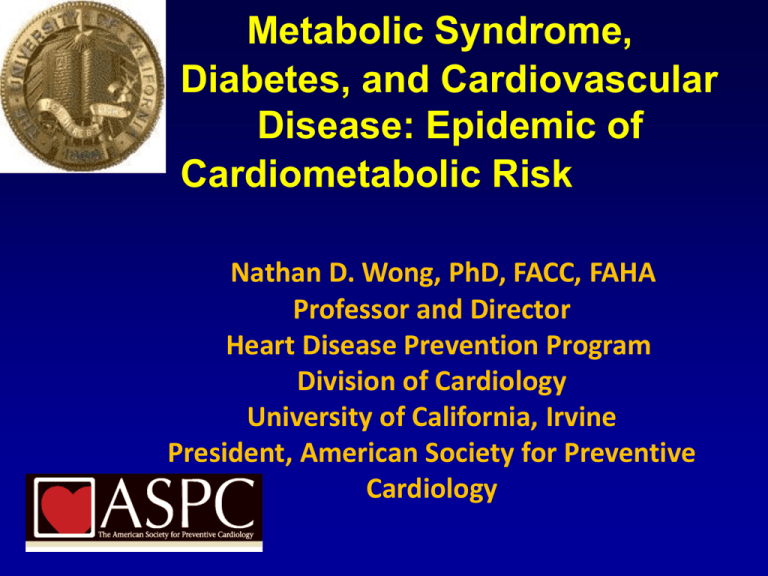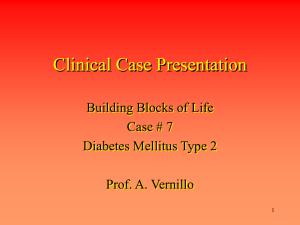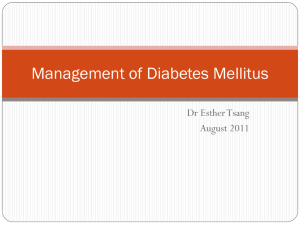
Metabolic Syndrome,
Diabetes, and Cardiovascular
Disease: Epidemic of
Cardiometabolic Risk
Nathan D. Wong, PhD, FACC, FAHA
Professor and Director
Heart Disease Prevention Program
Division of Cardiology
University of California, Irvine
President, American Society for Preventive
Cardiology
Age-adjusted prevalence of obesity in adults 20–
74 years of age, by sex and survey year
(NHES: 1960–1962; NHANES: 1971–1975, 1976–
1980, 1988–1994, 1999-2002 and 2003-2006).
.
40
35
30
Percent of Population
34.0
33.1
35.2
28.1
26.0
25
20.6
20
15.7
15
10.7
12.2
16.8
17.1
12.8
10
5
0
Men
1960-62
Women
1971-75
1976-80
1988-94
1999-2002
2003-06
Obesity is defined as a BMI of ≥30.0. Source: Health, United States, 2009 (NCHS).
©2010 American Heart Association, Inc. All rights reserved.
Roger VL et al. Published online in Circulation Dec. 15, 2010
Diabetes: A Growing Challenge
Prevalence in the United States
7
20
Diagnosed Diabetes
16
Number (Millions)
5
% of Population
18
Percentage of Population
14
12
4
10
3
8
6
2
4
1
2
Centers for Disease Control and Prevention, Division of Diabetes Translation.
National Diabetes Surveillance System. Available at http://www.cdc.gov/diabetes/statistics.
2006
2003
2000
1997
1994
1991
1988
1985
1982
1979
1976
1973
1970
1967
1964
1961
0
1958
0
# of Patients in Millions
6
Age-Adjusted Prevalence of Type 2 DM: California Adults
Aged >18 Including Hispanic and Asian Subgroups 2009
N.D. Wong, California Health Interview Survey (unpublished)
Natural History of Type II Diabetes Mellitus
Years from
diagnosis
-10
-5
0
Onset
Diagnosis
5
10
Insulin resistance
Insulin secretion
Postprandial
glucose
Microvascular complications
Fasting glucose
Macrovascular complications
Pre-diabetes
Ramlo-Halsted BA et al. Prim Care. 1999;26:771-789
Nathan DM et al. NEJM 2002;347:1342-1349
Type II diabetes
15
Diagnostic Criteria for
Glycemic Abnormalities
FPG
Hemoglobin A1C
2-Hour PG on OGTT
Diabetes Mellitus
Diabetes Mellitus
Diabetes Mellitus
126 mg/dL
7.0 mmol/L
6.5%
Prediabetes
100 mg/dL
Prediabetes
5.6 mmol/L
Normal
200 mg/dL
6.0%
140 mg/dL
Impaired Glucose
Tolerance
Normal
11.1 mmol/L
7.8 mmol/L
Normal
To convert mg/dL to mmol/L multiply mg/dl by 0.055
FPG=Fasting plasma glucose, PG=Plasma glucose, OGTT=Oral glucose tolerance test
The Expert Committee on the Diagnosis and Classification of Diabetes Mellitus. Diabetes Care 2001;24:S5-S20
American Diabetes Association. Diabetes Care 2010;33:S11-61
Diabetes Mellitus:
Lifetime Risk
Narayan et al. JAMA 2003;290:1884-1890.
Diabetes and CVD
• Atherosclerotic complications responsible for
– 80% of mortality among patients with diabetes
– 75% of cases due to coronary artery disease
(CAD)
– Results in >75% of all hospitalizations for diabetic
complications
• 50% of patients with type 2 diabetes have
preexisting CAD. (This number may be less now
that more younger people are diagnosed with
diabetes.)
• 1/3 of patients presenting with myocardial
infarction have undiagnosed diabetes mellitus
Lewis GF. Can J Cardiol. 1995;11(suppl C):24C-28C
Norhammar A, et.al. Lancet 2002;359;2140-2144
Mechanisms by which Diabetes Mellitus
Leads to Coronary Heart Disease
Hyperglycemia
Insulin Resistance
Inflammation
Infection
IL-6
CRP
SAA
Defense
mechanisms
Pathogen burden
HTN
Endothelial
dysfunction
AGE
Oxidative
stress
Dyslipidemia
LDL
TG
HDL
Subclinical Atherosclerosis
Thrombosis
PAI-1
TF
tPA
Disease Progression
Atherosclerotic Clinical Events
AGE=Advanced glycation end products, CRP=C-reactive protein, CHD=Coronary heart disease HDL=Highdensity lipoprotein, HTN=Hypertension, IL-6=Interleukin-6, LDL=Low-density lipoprotein, PAI-1=Plasminogen
activator inhibitor-1, SAA=Serum amyloid A protein, TF=Tissue factor, TG=Triglycerides, tPA=Tissue
plasminogen activator
Biondi-Zoccai GGL et al. JACC 2003;41:1071-1077.
Most Cardiovascular Patients Have
Abnormal Glucose Metabolism
GAMI
n = 164
31%
35%
34%
Normoglycemia
EHS
n = 1920
37%
18%
45%
Prediabetes
CHS
n = 2263
27%
37%
36%
Type 2 Diabetes
GAMI = Glucose Tolerance in Patients with Acute Myocardial Infarction study;
EHS = Euro Heart Survey; CHS = China Heart Survey
Anselmino M, et al. Rev Cardiovasc Med. 2008;9:29-38.
Age-adjusted CVD death rate
per 10,000 person years
Age-Adjusted CVD Death Rates
(MRFIT)
No. of risk factors (total cholesterol, HTN, smoking)
CVD=cardiovascular disease
MRFIT=multiple risk factor intervention trial
Adapted with permission from Stamler J
et al. Diabetes Care. 1993;16:434-444.
Diabetes Mellitus:
Survival Following a Myocardial Infarction
Minnesota Heart Survey
100
MEN
WOMEN
No diabetes
No diabetes
Survival (%)
80
n=1628
n=568
Diabetes
60
Diabetes
n=228
40
n=156
Months Post-MI
0
0
20
40
60
MI=Myocardial infarction
Sprafka JM et al. Diabetes Care 1991;14:537-543.
Months Post-MI
80
0
20
40
60
80
Risk of Cardiovascular Events in Patients
with Diabetes: Framingham Study
_________________________________________________________________
Cardiovascular Event
Age-adjusted
Biennial Rate
Per 1000
Men Women
Age-adjusted
Risk Ratio
Men Women
Coronary Disease
Stroke
Peripheral Artery Dis.
Cardiac Failure
All CVD Events
39
15
18
23
76
1.5**
2.9***
3.4***
4.4***
2.2***
21
6
18
21
65
2.2***
2.6***
6.4***
7.8***
3.7***
_________________________________________________________________
Subjects 35-64 36-year Follow-up
**P<.001,***P<.0001
Diagnostic Criteria for Metabolic
Syndrome: Modified NCEP ATP III
≥3 Components Required for Diagnosis
Components
Defining Level
Increased waist circumference
Men
Women
Elevated triglycerides
Reduced HDL-C
Men
Women
Elevated blood pressure
Elevated fasting glucose
AHA/NHLBI Scientific Statement; Circulation 2005; 112:e285-e290.
≥ 40 in
≥ 35 in
≥150 mg/dL
(or Medical Rx)
<40 mg/dL
<50 mg/dL
(or Medical Rx)
≥130 / ≥85 mm Hg
(or Medical Rx)
≥100 mg/dL
(or Medical Rx)
IDF Criteria: Abdominal Obesity and
Waist Circumference Thresholds
Men
Women
Europid
≥ 94 cm (37.0 in)
≥ 80 cm (31.5 in)
South Asian
≥ 90 cm (35.4 in)
≥ 80 cm (31.5 in)
Chinese
≥ 90 cm (35.4 in)
≥ 80 cm (31.5 in)
Japanese
≥ 85 cm (33.5 in)
≥ 90 cm (35.4 in)
• AHA/NHLBI criteria: ≥ 102 cm (40 in) in men, ≥ 88 cm (35 in) in women
• Some US adults of non-Asian origin with marginal increases should benefit
from lifestyle changes. Lower cutpoints (≥ 90 cm in men and ≥ 80 cm in
women) for Asian Americans
>90cm (male) and >80cm (female) recommended for persons of Central and
South American ancestry (including US Hispanics)
Alberti KGMM et al. Lancet 2005;366:1059-1062. | Grundy SM et al. Circulation 2005;112:2735-2752.
Intra-abdominal (Visceral) Fat
The dangerous inner fat!
Front
Visceral AT
Subcutaneous AT
Back
Pericardial Fat Predicts CVD Risk
MACE patient (CABG): 58-year-old woman with BMI 32.8 and CCS
= 0, PFV = 187 cm3 and TFV 315 cm3
After adjustment for Framingham risk score (FRS), CCS, and body mass
index, PFV and TFV were significantly associated with MACE (odds ratio
[OR]: 1.74, 95% confidence interval [CI]: 1.03 to 2.95 for each doubling of
PFV; OR: 1.78, 95% CI: 1.01 to 3.14 for TFV).
Cheng et al. JACC Img 2010;3:352-60
Abdominal Adiposity Is Associated
With Increased Risk of Diabetes
Relative Risk of Diabetes
25
P value for trend <0.001
20
15
10
5
0
<28 >28-29 30-31 32-33 34-35 36-37
Waist Circumference (in)
Carey VJ, et al. Am J Epidemiol. 1997;145:614-619
≥38
Metabolic Syndrome and Diabetes in Relation to CHD, CVD,
and Total Mortality: U.S. Men and Women Ages 30-74
(Risk-factor Adjusted Cox Regression) NHANES II Follow-up (n=6255)
7
***
6
Relative Risk
***
5
***
None
4
MetS
***
***
3
***
Diabetes
***
2
***
*
**
***
CVD
***
1
CVD+Diabetes
0
CHD Mortality
CVD Mortality
Malik and Wong, et al., Circulation 2004.
Total Mortality
* p<.05, ** p<.01, **** p<.0001 compared to none
Annual CHD Event Rates (in %) by Calcium Score Events by
CAC Categories in Subjects with DM, MetS, or Neither Disease
(Malik and Wong et al., Diabetes Care 2011)
Coronary Heart Disease
4
Annual
CHD
Event
Rate
4
3.5
3
2.5
2
1.5
1
0.5
0
3.5
1.9
1.5
0.4
0.8
0.2
0.1
0
2.1
0.4
1-99
2.2
1.3
DM
MetS
Neither MetS/DM
100-399
400+
Coronary Artery Calcium Score
•ACCF/AHA 2010 Guideline: CAC Scoring for CV risk assessment in
asymptomatic adults aged 40 and over with diabetes (Class IIa-B)
Summary of Care:
ABC's for Providers
A
B
C
D
E
F
A1c Target
Aspirin Daily
Blood Pressure Control
Cholesterol Management
Cigarette Smoking Cessation
Diabetes and Pre-Diabetes
Management
Exercise
Food Choices
Under-Treatment of Cardiovascular Risk
Factors Among U.S. Adults with Diabetes
– NHANES Survey 2001-2002, 532 (projected to 15.2 million)
or 7.3% of adults aged >/=18 years had diabetes
– 50.2% not at HbA1c goal <7%
– 64.6% not at LDL-C goal <100 mg/dl
– 52.3% not at recommended HDL-C >/=40 (M), >/=50 (F)
– 48.6% not at recommended triglycerides <150 mg/dl
– 53% not at BP goal of <130/80 mg/dl
– Overall, only 5% of men and 12% of women at goal
for HbA1c, BP, and LDL-C simultaneously
Malik S, Wong ND et al. Diab Res Clin Pract 2007;77:126-33.
Summary of Care:
ABC's for Providers
A A1c Target
Aspirin Daily
B
C
D
E
F
Blood Pressure Control
Cholesterol Management
Cigarette Smoking Cessation
Diabetes and Pre-Diabetes
Management
Exercise
Food Choices
A1c Target
Aspirin Therapy
• A1c Target: In persons with diabetes, glucose
lowering to achieve normal to near normal
plasma glucose, as defined by the HbA1c<7% also consider measurement of HbA1c for CVD
risk assessment in asymptomatic adults w/o DM
(ACCF/AHA 2010)
• Aspirin Daily: Patients with type 2 DM >40
years of age or with prevalent CVD, OR those
with metabolic syndrome without DM who are at
intermediate or higher risk (e.g., >=10% 10-year
risk of CHD)
Diabetes Mellitus:
Effect of Aspirin
25
p<0.002
p=NS
20
Endpoint (%)
No ASA
ASA
p < 0.001
p=.04
15
p<0.05
10
p=NS
5
p=NS
0
PHS
n=
Endpoint
# Events
ETDRS
APT
BIP
PPP
POPADAD
JPAD
533
3711
4502
2368
1031
1276
2539
5 yr MI
7 yr MI
1 yr MCE
5 yr CV Death 4 yr MCE 7yr MCE
4 yr MCE
26 vs 11 283 vs 241 502 vs 415 183 vs 133 20 vs 22
117 vs 116 86 vs 68
NS=Not Significant
1. Steering Committee of the Physicians' Health Study
Research Group. NEJM 1989;321:129-35
2. ETDRS Investigators. JAMA 1992;268:1292
3. Antiplatelet Trialists' Collaboration. BMJ 1994; 308:81
4. Harpaz D et al. Am J Med 1998;105:494
3. Sacco M et al. Diabetes Care 2003;26:3264
4. Belch J et al. BMJ 2008; 337:a1840
5. Ogawa H et al. JAMA 2008; 300: 2134
Diabetes Mellitus:
Impact of Glycemic Control on CV Risk
United Kingdom Prospective Diabetes Study (UKPDS) 35
60
50
5.5%
6.5%
7.5%
8.5%
9.5%
10.5%
%
40
30
20
10
0
Myocardial Infarction
Microvascular Disease
CHD=Coronary heart disease, HbA1C=Glycated hemoglobin
Stratton IM et al. BMJ 2000;321:405-12
Diabetes Mellitus (Type II):
Effect of Intensive Glycemic Control
United Kingdom Prospective Diabetes Study (UKPDS)
3,867 patients with DM randomized to intensive therapy with a sulphonylurea
or insulin (mean HbA1C 7.0%) or conventional therapy (mean HbA1C 7.9%)
0
-12
-10
-16
-21
-20
-25
P=0.05
P=0.03
P=0.02
P<0.01
-30
-33
P<0.01
-40
-50
Microalbuminuria at 12 years
Retinopathy
Any DM endpoint
Microvascular complications
Myocardial infarction
Intensive glycemic control in DM reduces the risk of microvascular
complications
DM=Diabetes mellitus, HbA1C=Glycosylated hemoglobin
UKPDS Group. Lancet 1998;352:837-853
UKPDS Metformin Sub-Study:
CHD Events
Coronary Deaths
Myocardial Infarction
Incidence per 1000 patient years
20
10
p=0.01
p=0.02
NS
8
39%
Reduction
15
50%
Reduction
6
10
4
5
0
2
0
Conventional Insulin
SU’s
Diet
n=
#Events
411
73
UKPDS 34, Lancet 352: 854, 1998
951
139
Metformin
342
39
Conventional
Diet
Metformin
411
36
342
16
Recent Trials Show No Reduction in CV Events with
More Intensive Glycemic Control
25
20
Intensive therapy
Standard therapy
15
10
5
0
0
1
Number at Risk
Intensive 5128 4843
Standard 5123 4827
1ACCORD
ADVANCE: Primary Outcome
Cumulative incidence (%)
Patients with events (%)
ACCORD: Primary Outcome
2
3
Years
4390 2839
4262 2702
4
1337
1186
5
6
475
440
448
395
Study Group. N Engl J Med. 2008;358:2545-2559.
Collaborative Group. N Engl J Med. 2008;358:2560-2572.
2ADVANCE
25
20
Intensive therapy
Standard therapy
15
10
5
0
0
Number at Risk
Intensive 5570
Standard 5569
12
24
36
48
Months of follow-up
5369
5342
5100
5065
4867
4808
4599
4545
60
1883
1921
Was Intensive Glycemic Control Harmful?
A closer look at ACCORD AND ADVANCE
• ACCORD was discontinued early due to increased
total and CVD mortality in the intensive arm.
• VA Diabetes Trial showed severe hypoglycemia to
be a powerful predictor of CVD events.
• A recent analysis of ACCORD (Diabetes Care,
May 2010) showed deaths related to unsuccessful
intensive therapy where A1c remained high.
• But in both ACCORD AND ADVANCE, those
without macrovascular disease at baseline had an
actual benefit in the primary endpoint.
Diabetes Mellitus (Type I):
Effect of Intensive Glycemic Control
Diabetes Control and Complications Trial (DCCT) and Epidemiology
of Diabetes Interventions and Complications (EDIC)
Conventional
Intensive
10%
8%
6%
P < 0.001
P < 0.001
P = 0.61
DCCT
End of
Randomized
Treatment
EDIC
Year 1
EDIC
Year 7
42% risk reduction
P =0.02
0.12
Cumulative Incidence
Hemoglobin A1C
12%
0.10
Conventional
0.08
0.06
0.04
0.02
Intensive
0.00
0
2
4
6
8 10 12 14 16 18 20
Years Since Entry*
Any cardiovascular outcome
Intensive glycemic control in DM reduces long-term CV risk
DCCT/EDIC Research Group. JAMA. 2002;287:2563-2569
Nathan DM, et al. N Engl J Med. 2005;353:2643-2653
Diabetes Mellitus (Type II):
Effect of Intensive Glycemic Control
United Kingdom Prospective Diabetes Study (UKPDS)
10-Year Follow-Up
Sulphonylurea vs.
Therapy
Conventional
Insulin vs.
Conventional
Therapy
Intensive glycemic control in DM reduces the long-term risk of
myocardial infarction
Holman RR et al. NEJM 2008;359:1577-89
2009 ADA/AHA/ACC Statement
Recommendations
• Goal of A1c<7% remains reasonable
– for uncomplicated patients
• ACC/AHA Class I (A)
– and for those with macrovascular disease
• ADA Level B; ACC/AHA Class IIb (A)
• Incremental microvascular benefit may be
obtained from even lower goals
• ADA Level B; ACC/AHA Class IIa (C)
• Less stringent goals may be appropriate for
those with labile glucose control or with
advanced micro- or macrovascular disease
• ADA Level C; ACC/AHA Class IIa (C)
Circulation 2009; 119: 351-357
Summary of Care:
ABC's for Providers
A
A1c Target
Aspirin Daily
B Blood Pressure Control
C
D
E
F
Cholesterol Management
Cigarette Smoking Cessation
Diabetes and Pre-Diabetes
Management
Exercise
Food Choices
UKPDS: Effects of Tight vs. Less-Tight
Blood Pressure Control
UK Prospective Diabetes Study Group. BMJ. 1998; 317:703-713.
Diabetes Mellitus:
Effect of Blood Pressure Control
Action to Control Cardiovascular Risk in Diabetes (ACCORD) Blood
Pressure Trial
4,733 diabetic patients randomized to intensive BP control (target SBP <120
mm Hg) or standard BP control (target SBP <140 mm Hg) for 4.7 years
HR=0.88
95% CI (0.73-1.06)
15
10
5
0
Patients with Events (%)
20
Total Stroke
Patients with Events (%)
Nonfatal MI, nonfatal
stroke, or CV death
20
HR=0.59
95% CI (0.39-0.89)
15
10
5
0
0
1
2
3
4
5
6
7
Years Post-Randomization
8
0
1
2
3
4
5
6
7
8
Years Post-Randomization
Intensive BP control in DM does not reduce a composite of adverse
CV events, but does reduce the rate of stroke
BP=Blood pressure, DM=Diabetes mellitus, HR=Hazard ratio, SBP=Systolic blood pressure
ACCORD study group. NEJM 2010
Scientific Statements:
Diabetes, CV Disease and Hypertension
• JNC VII Report on Diabetic Hypertension
– BP goal (<130/80 mm Hg)
• Commonly requiring combinations of ≥2 drugs
– ACEIs, CCBs, Thiazide-diuretics, -blockers,
and ARBs shown to reduce CVD/CVA risk
– ACEIs/ARBs reduce progression of diabetic
nephropathy and reduce albuminuria
– ARBS reduce progression of macroalbuminuria
Grundy SM, et al. Circulation. 1999;100:1134-1146.
Chobanian AV, et al. JAMA. 2003;289:2560-2572.
Summary of Care:
ABC's for Providers
A
B
A1c Target
Aspirin Daily
Blood Pressure Control
C Cholesterol Management
D
E
F
Cigarette Smoking Cessation
Diabetes and Pre-Diabetes
Management
Exercise
Food Choices
Diabetes Mellitus:
Effect of an HMG-CoA Reductase Inhibitor
Meta-analysis of 18,686 patients with DM randomized to treatment
with a HMG-CoA Reductase Inhibitor
Statins reduce CV events 21% in diabetics (similar to non-diabetics)
Cholesterol Treatment Trialists’ (CTT) Collaborators. Lancet 2008;37:117-25
ACCORD Lipid Study Results
(NEJM 2010; 362: 1563-74)
• 5518 patients with type 2 DM treated with open
label simvastatin randomly assigned to
fenofibrate or placebo and followed for 4.7
years.
• Annual rate of primary outcome of nonfatal MI,
stroke or CVD death 2.2% in fenofibrate group
vs. 1.6% in placebo group (HR=0.91, p=0.33).
• Pre-specified subgroup analyses showed a
benefit in men vs. women and those with high
triglycerides and low HDL-C.
• Results support statin therapy alone to reduce
CVD risk in high risk type 2 DM patients.
Lipid Goals for Persons with Metabolic
Syndrome and DM (Grundy et al., 2005)
LDL-C targets, ATP III guidelines
–High Risk: CHD, CHD risk equivalents (incl.
DM or >20% 10-year risk): <100 mg/dL
(option <70 mg/dl if CVD present)
– Moderately High Risk (10-20%) 2 RF: <130
mg/dL, option <100 mg/dL
– Moderate Risk (2+ RF, <10%) <130 mg/dL
-- Low Risk: 0-1 RF: <160 mg/dL
HDL-C: >40 mg/dL (men)
>50 mg/dL (women)
TG: <150 mg/dL
Specific Dyslipidemias:
Elevated Triglycerides
Non-HDL: Secondary Target
• Non-HDL = TC – HDL
• Non-HDL: secondary target of therapy
when serum triglycerides are 200
mg/dL (esp. 200-499 mg/dl)
• Non-HDL goal: LDL goal + 30 mg/dL
Summary of Care:
ABC's for Providers
A
B
C
D
E
F
A1c Target
Aspirin Daily
Blood Pressure Control
Cholesterol Management
Cigarette Smoking
Cessation
Diabetes and Pre-Diabetes
Management
Exercise
Food Choices
Cigarette Smoking Cessation Recommendations
Goals
Complete cessation
No environmental
tobacco smoke exposure
I IIa IIb III
Recommendations
Ask about tobacco use at every visit
In a clear, strong, and personalized manner, advise the
patient to stop smoking
Urge avoidance of exposure to second-hand smoke at
work and home
Assess patient’s willingness to quit smoking
Develop a plan for smoking cessation and arrange
follow-up
Provide counseling, pharmacologic therapy, and
referral to a formal cessation program
Smith SC Jr. et al. JACC 2006;47:2130-9
The 5 “A’s” for Effective
Smoking Intervention
1. ASK about smoking
2. ADVISE to quit
3. ASSESS willingness to make a quit
attempt
4. ASSIST if ready - offer therapy and
consultation for quit plan and if not,
then offer help when ready
5. ARRANGE follow up visits
Summary of Care:
ABC's for Providers
A
B
C
A1c Target
Aspirin Daily
Blood Pressure Control
Cholesterol Management
Cigarette Smoking Cessation
D Diabetes and Pre-Diabetes
Management
E
F
Exercise
Food Choices
Diabetes Prevention Program:
Reduction in Diabetes Incidence
Pre-diabetic Conditions:
Benefit of a Thiazolidinedione
Actos Now Study for the Prevention of Diabetes (ACT NOW)
602 patients with impaired glucose tolerance + impaired fasting glucose
randomized to pioglitazone (45 mg) or placebo for up to 4 years
Conversion to DM*
(%/year)
81% RRR
9
6.8
6
3
0
1.5
P<0.00001
Placebo
Pioglitazone
A thiazolidinedione reduces the risk of DM
*Defined as a fasting glucose measurement >126 mg/dL or a glucose level of >200 mg/dL following an OGTT
with repeat OGTT for confirmation
DM=Diabetes mellitus, OGTT=Oral glucose tolerance test, RRR=Relative risk reduction
DeFronzo RA et al. Presented at the 68th Annual Scientific Sessions of the American Diabetes Association, June
6, 2008, San Francisco, CA
Risk of Developing Diabetes Mellitus
Among Different Antihypertensive Agents
Systematic review of 22 clinical trials evaluating 143,153 patients without DM
randomized to an antihypertensive agent
Treatment with an ARB or ACE inhibitor carries the lowest risk of developing
DM, whereas treatment with a diuretic or -blocker carries the highest risk
ACE=Angiotensin converting enzyme, ARB=Angiotensin receptor blocker, DM=Diabetes mellitus
Elliott WJ et al. Lancet 2007;369:201-7
Benefit of Comprehensive, Intensive
Management: STENO 2 Study
Primary End Point=CV events (%)
60
• Treatment Goals:
–
–
–
–
–
Intensive TLC
HgbA1c <6.5%
Cholesterol <175
Triglycerides <150
BP <130/80
Conventional Therapy
Intensive Therapy
50
40
30
20
n =80
10
0
0
12
24
36
48
60
Months of Follow Up
Gaede, P. et al, NEJM 2003;348:390-393
n =80
72
84
96
Summary of Care:
ABC's for Providers
A
B
C
D
A1c Target
Aspirin Daily
Blood Pressure Control
Cholesterol Management
Cigarette Smoking Cessation
Diabetes and Pre-Diabetes
Management
E Exercise
F
Food Choices
AHA Diabetes Mellitus Recommendations
Goals
Recommendations
Intensive lifestyle modification to prevent the
development of DM (especially in those with the
metabolic syndrome)
I IIa IIb III
I IIa IIb III
Vigorous modification of other CV risk factors (e.g.
physical activity, weight management, blood
pressure control, and cholesterol management)
Initiate lifestyle and pharmacotherapy to achieve
near-normal HBA1C
Coordination of diabetic care with the patient’s
primary physician and/or endocrinologist
CV=Cardiovascular, DM=Diabetes mellitus, HbA1C=Glycosylated hemoglobin
Smith SC Jr. et al. JACC 2006;47:2130-9
RCT Trial Assessment of Pedometer
Interventions
N=277; 8 Trials
Pedometer increased steps by 2500/day
Bravata, DM et al. JAMA 2007; 298:2296-2304
Summary of Care:
ABC's for Providers
A
B
C
D
E
A1c Target
Aspirin Daily
Blood Pressure Control
Cholesterol Management
Cigarette Smoking Cessation
Diabetes and Pre-Diabetes
Management
Exercise
F Food Choices
Effect of Mediterranean-Style Diet
in the Metabolic Syndrome
• 180 pts with metabolic
syndrome randomized to
Mediterranean-style vs.
prudent diet for 2 years
• Those in intervention
group lost more weight
(-4kg) than those in the
control group (+0.6kg)
(p<0.01), and significant
reductions in CRP and
Il-6
Esposito K et al. JAMA 2004; 292(12): 1440-6.
Therapeutic Lifestyle Changes
Nutrient Composition of TLC Diet
Nutrient
Recommended Intake
•
•
•
•
•
•
•
Less than 7% of total calories
Up to 10% of total calories
Up to 20% of total calories
25–35% of total calories
50–60% of total calories
20–30 grams per day
Approximately 15% of total
calories
Less than 200 mg/day
Balance energy intake and
expenditure to maintain
desirable body weight/
prevent weight gain
Saturated fat
Polyunsaturated fat
Monounsaturated fat
Total fat
Carbohydrate
Fiber
Protein
• Cholesterol
• Total calories (energy)
Sodium intake should be <1500 mg/day (AHA 2011)
My Life Check Assessment
My Life Check Assessment
My Life Check Assessment
Age-standardized prevalence estimates for poor, intermediate and ideal cardiovascular health
for each of the seven metrics of cardiovascular health in the AHA 2020 goals, among US adults
>20 years of age, NHANES 2005-2006 (baseline available data as of January 1, 2010).
100.0
22.9
33.2
80.0
45.2
46.6
41.7
61.4
72.2
Percentage
60.0
32.9
23.2
40.0
76.8
38.4
41.2
3.2
20.0
30.4
33.8
24.5
31.7
15.0
17.1
8.2
0.0
Current Body Mass Physical Healthy
Total
Blood
Smoking
Index
Activity Diet Score Cholesterol Pressure
Poor
©2010 American Heart Association, Inc. All rights reserved.
Intermediate
Ideal
Fasting
Plasma
Glucose
Roger VL et al. Published online in Circulation Dec. 15, 2010
Conclusions
• Metabolic syndrome and diabetes are
associated with increased levels of
atherosclerosis and cardiovascular
disease event risk
• Lifestyle measures focusing on weight
reduction, dietary, and physical activity
guidance are crucial in initial
management.
Conclusions (cont.)
• Clinical management emphasizes
achievement of BP and lipid goals,
glycemic control, and antiplatelet therapy.
• Multidisciplinary programs including
primary care physicians, specialists
(endocrinologists and cardiologists),
dietitians, and exercise specialists are key
for the successful management of these
conditions.
Braunwald’s Preventive
Cardiology Now Available
www.heart.uci.edu
Join the ASPC at
www.aspconline.org






